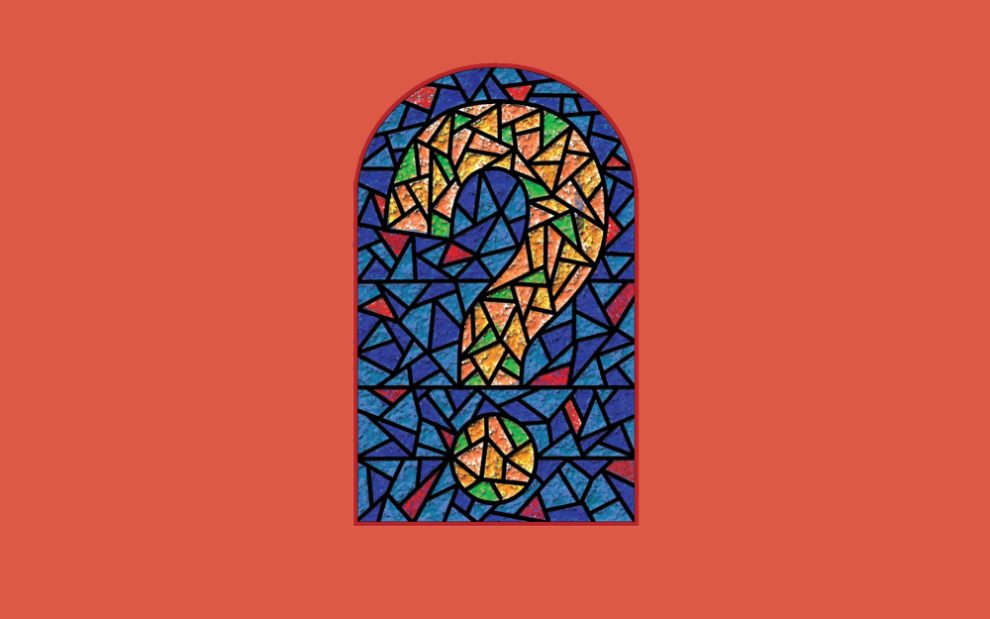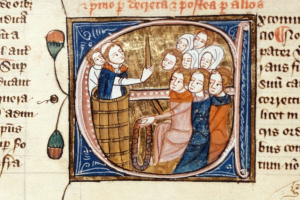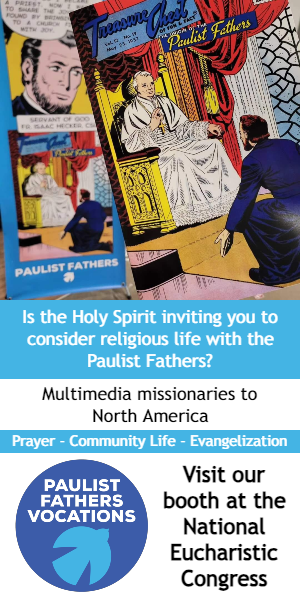When Mary gave birth to Jesus, what was it like? Did she experience the same anxiety, fear, mess, and pain that any woman can expect when preparing for childbirth? Many people might find this question strange. Of course Mary, being fully human, and not God, would share in all the usual feelings and emotions—both pleasant and unpleasant—associated with bringing a baby into the world. Wouldn’t she?
For centuries of church history, many Catholics would have answered this question with a resounding “no,” or at least with a “probably not.” This is because of a complex intertwining of beliefs and theories, some associated with theologies of sin, others associated with ideas about women’s bodies. Even today, there are many Catholics who are appalled at the idea that Mary experienced pain when she gave birth to baby Jesus.
On this final episode of this season of the Glad You Asked podcast, the hosts talk to theologian Julia Feder about the background of this tradition, why it has been so popular among some Catholics, what the church actually teaches, and what’s at stake for people trying to assess what they should believe. Feder is the assistant director of the Center for the Study of Spirituality, as well as an associate professor of religious studies and theology at Saint Mary’s College, and is the author of Incarnating Grace: A Theology of Healing from Sexual Trauma (Fordham University Press).
Learn more about this topic and read some of Feder’s writing in the links below.
- “The Pregnancy of Mary,” by Nathan Schneider
- “There would have been a midwife at the stable,” by Christine Schenk
- “What are we missing in our depictions of the nativity?” by Kelley Nikondeha
- “Mary, Mary, quite contrary,” by Elizabeth Johnson
- “Reclaiming the virgin martyrs from purity culture,” by Julia Feder
The following is a transcript of this episode of Glad You Asked.
Rebecca Bratten Weiss: Welcome to Glad You Asked, the podcast where we answer the questions about Catholicism that are easy to ask but not so easy to answer. I’m Rebecca Bratten Weiss, digital editor at U.S. Catholic.
Cassidy Klein: And I’m Cassidy Klein, editorial assistant at U.S. Catholic. On today’s episode, the last of this season, we’re going to discuss a question that may sound strange to some, but which has been discussed among Catholics for centuries: Did Mary experience labor pains?
Rebecca: What’s the background of this tradition? Why do some Catholics believe this? And what should Catholics believe? Our guest today is going to help us explore these questions.
Cassidy: Julia Feder is assistant director of the Center for the Study of Spirituality, as well as associate professor of religious studies and theology at Saint Mary’s College, and the author of Incarnating Grace: A Theology of Healing from Sexual Trauma (published by Fordham University Press).
Rebecca: Julia, thanks so much for joining us on the Glad You Asked podcast.
Julia Feder: Thanks for having me. I’m really happy to be here.
Cassidy: To begin, could you give some background for this belief that Mary didn’t have labor pains? Like why have so many Catholic church leaders and theologians believed this?
Julia: Yeah, I think that there are a few different threads that come together to make this even be a question at all. The first one is the second creation narrative in Genesis. So that’s the creation narrative that focuses on Adam and Eve. And what’s really critical here is that after Adam and Eve disobeyed God’s command, and they eat the fruit, God’s response to the first human beings’ disobedience is a set of what people call later curses. And to the woman, God says, “I will greatly increase your pains in childbearing. In pain you shall bring forth children, yet your desire shall be for your husband and he shall rule over you.” So this story becomes later, for Christians, the imaginative foundation for the Christian doctrine of original sin. So this idea that we are born into the world by sin before we even have the chance to make any personal choices of our own. So it’s the idea that we’re affected by the sins of those who have gone before us. So it can kind of suggest that pain in childbirth is not a part of God’s original desire for human beings and that labor pain is part of a suite of human experiences like hunger and in this verse that I just read, the male domination of women, a suite of human experiences that should have never been but exist because of human sin. So that’s one thread.
The other thread that comes together is that in scripture we hear that Jesus’ birth is a special kind of birth. So the gospels of Luke and Matthew both suggest that Jesus is conceived by the Holy Spirit and Mary is a virgin who will give birth, so it’s not our usual experience of people who give birth, because nothing’s impossible with God. So Mary is a virgin at the time of Jesus’ conception. And, you know, different people have thought about what this might mean, but at the very least it suggests that God, this is God’s initiative. This is not something that a human male initiated.
Over time, theologians and Christian thinkers who are interested in emphasizing the special nature of Jesus’ birth amplify the idea that Mary was a different kind of mother than other mothers. She had a different kind of mothering experience. So Mary is imagined to not only be a virgin before birth, that’s often talked about as being a virgin antepartum, but eventually during birth and after birth, so in postpartum. And this idea is given official status in the Christian church in 649, so the seventh century, and Mary is thought of as ever-virgin, the perpetual virgin. The reason for this is that her virginity points to her own holiness, and this holiness allows her to birth Jesus, the one who’s without sin. Her holiness allows for a full union of God and humanity in the person of Jesus Christ. And this idea was, by like the second or third century, the idea was that sexual passion in the act of conception stains the soul of a human who is conceived. So if Mary opts out of sexual activity, that provides a special guarantee of Jesus’ sinlessness. And by the third century, Mary’s perpetual virginity comes to serve as a model for lots of different women’s kind of holiness in the church once the end of, once the age of martyrs has come to a close, so women aren’t facing death at the hands of Roman imperial authorities anymore. They can express their desire to live a holy life by living an exceptional life of virginity, free from the earthly concerns of marriage and children, and free to focus on a desire for heaven. So that’s the second strand. Jesus’ birth is really special. And then the third one that develops later is this idea that Mary herself is conceived without original sin. So this was a matter of debate throughout Christian tradition through the Middle Ages. And famously Bernard of Clairvaux in the 12th century thought this was a bad idea to start talking about Mary as conceived without original sin, but folks like John Duns Scotus in the 13th and 14th century argued for it. But in the 19th century, it’s officially designated as church teaching in 1854 by Pope Pius IX. And he explains, he defines the idea of the immaculate conception that says that God chose Mary to be free from original sin before time began to prepare her to, for this act of being Jesus’ mother. And he talks about her as a land entirely intact. So these three different threads come together in different ways throughout the tradition. So the idea of birth being tied, labor pains being tied to sin, the idea that Jesus’ birth is special, and the idea that Mary’s conceived without original sin come together in different ways. People have different ideas about it through the tradition. But for some Christian thinkers, all of these three things come together to suggest that if in the person of Jesus Christ we have this full union of divinity and humanity, then we must have in his conception and birth the cooperation of a human being, Mary, with God. And so Mary’s full humanity guarantees that he’s really human, but for him to be fully divine, she also must be free from sin in a special way. And it’s her sinlessness that makes her conception of Jesus different, but not just her conception, the process of giving birth to him different. She’s not under the curse of Eve, some people imagine, and so for some Christian thinkers they imagine this would make the process of birth painless.
Rebecca: So bringing together all of these threads, do we know where this idea that Mary didn’t have labor pains originated? When do we first encounter this in the Catholic tradition?
Julia: One of the earliest places that we find this is in the second century in the Protoevangelium of James. So this is a non-canonical, apocryphal infancy account of the birth of Mary and of Jesus, actually. And it talks about Mary giving birth to Jesus in a sort of, she goes into a cave and there’s this light that emanates from the cave. A midwife has been called, but the midwife turns out to be unnecessary, and he just sort of emanates from this ray of light. So there’s no real labor at all. After that, this is one of the more interesting parts of the text I think, the midwife asks for the assistance of Salome, who’s a woman who is asked to inspect her body, Mary’s own body, to see whether any physical markers of virginity are still there or not. They’re trying to imagine what happened to her body if he just sort of emanated out of her. So Salome tries to put her hand inside of Mary’s body and her hand starts to fall off and feel like it’s burning. And so she’s not able to inspect Mary’s body after all. And so you get these stories in this text to suggest, you get the impression that these are proofs that Jesus has been conceived by the Holy Spirit and is not the product of any sexual misconduct on Mary’s part or sexual misconduct of anyone else who the author seems to be most concerned, who might have sinned against Joseph’s honor in violating his betrothed. You also can hear in here that there’s a concern from some probably male Christian thinkers who are concerned about whether Jesus’ birth would have destroyed Mary’s physical virginity. We know of course that there is no such thing today, but they would have been concerned about whether her body was less intact in some way. So I sort of cringe a little bit to bring it up, but you know, the idea was that a woman’s hymen breaking represents the sealing of the marriage contract. So this is what they would have had a lot of questions about. And in fact, what maybe Salome would have been trying to inspect and was thwarted by Mary’s own body burning her and protecting itself from this kind of intrusion. And so by the fourth century, this theme of the intactness of Mary’s body through birth, before birth, during and after birth becomes this common analogy that Christian thinkers use to describe the integrity of the church itself, the intactness of the church itself that cannot be broken down or violated by the church’s enemies.
Cassidy: So if a person believes Mary gave birth without pain, what does this mean on a practical, like biological level? How do these people believe Jesus actually was born?
Julia: Yeah, that’s a great question. And one that some of these early texts don’t want to give an answer for, right? So, you know, in the Protoevangelium of James, she’s in this cave and this light emanates and we don’t really know how it happened. You know, asking these kinds of questions, it seems like those who have this kind of position seem to think it’s almost impolite or intrusive to probe in this way to ask for some of these biological details, which is an interesting detail, I think.
Rebecca: So I appreciate that. And I kind of wish that some of the male theologians had been more respectful in their own questions. And that brings me to the next question, which is, how does this particular tradition of thinking connect to some other beliefs about Mary? You mentioned some of the others. But are there some others we should be aware of?
Julia: Yeah, I can add, you know, this interest in the intactness of Mary’s body extends into the 20th century. In 1950, the dogma of the assumption is defined. So this is the idea that the intactness of Mary’s body extends after death so that her body and her soul are never separated from each other at all. There’s such a unity between her body and soul that she never experiences any alienation from her body even after death. And I think in general we can think, I think it’s worth mentioning, that any kind of thinking about Mary in the tradition always is placed in this tension between two different ideas. One, that Mary’s unique and unlike the rest of us, and that’s because Christ’s saving work is anticipated in her and made special. And on the other side of the tension, she’s radically one of us. She’s just like us. She has solidarity with us and that’s because she’s someone who, like us, needs to be saved by Christ. And so, the other big shift I think that’s important to talk about in the development of thinking about Mary is actually Vatican II. So Vatican II represents a change in thinking about both Mary and the church. So Vatican II marks a change going from static, idealized notions of Mary’s perfection and the church’s perfection to a more realistic articulation of the struggle of discipleship and human life, both in Mary’s life and in the church as a whole. So it’s interesting and significant that at Vatican II, Mary isn’t given her own document. She is treated within Lumen gentium, the document that outlines the theology of the church. And that’s a document that talks a lot about the church as the people of God who need redemption. And Mary is one of the members of the church, maybe perhaps an exemplary member of the church, but a member nonetheless who was in need of redemption from Christ. And Vatican II also marked a similar change in thinking about the saints. So we transition from like a patron petitioner model to more of a model of communion and solidarity. So we have this emphasis after Vatican II on Mary being one of us, rather than somebody who is unique and set apart from us. So I think that’s a long way of saying, I think this conversation about whether Mary suffered from labor pains has something to do with how we think about Mary in general and how we have thought about her. Are we more interested in emphasizing a special kind of intactness of her body that sets her apart from the experiences of ordinary women? Or is she radically united with us and shows us perhaps maybe exemplary ways of following Christ in the midst of normal experiences like giving birth, lactating, surviving postpartum, et cetera.
Cassidy: So how are these beliefs connected with certain ancient or medieval assumptions about women and childbirth?
Julia: I think there’s a lot of beliefs that are latent in some of these conversations that deserve to be pulled out. I’ll just mention two. One is that childbirth makes one unclean or damaged, and that pain in childbirth is related to a personal sin. These are some assumptions that ancient people and Christian people have made throughout the tradition that might not be helpful.
Rebecca: So what is the church’s actual official teaching on this particular question now? Or does the church have a particular teaching on this question now?
Julia: Yeah, there isn’t an official church teaching on Mary and the degree to which she experienced pain and labor. There is official church teaching that Mary is a perpetual virgin, meaning that before, during, and after birth she remains a virgin. That’s its own complicated conversation about, well, what would that even mean? But it seems clear to me that it doesn’t need to mean that Mary never experienced pain in childbirth.
Cassidy: As a theologian, do you have a view on how Catholics should regard this question about Mary and labor pains?
Julia: I think it’s a really interesting question and I think one that’s really important to ask actually. I don’t think that there is one clear answer on it. My sense would be that I think it’s really important to think about Mary as somebody who was, though she was free from sin, still lived an ordinary, full life, a life of struggle and sometimes extraordinary struggle. So we know from scripture, especially Luke’s account, that she often didn’t know what was coming next. She didn’t know how to make sense of her own experiences. She pondered things deeply in her heart. And we also know that she suffered acutely from the sins of other people. So Jesus’s death, own death, is the clearest example of that. And she, the tradition of thinking of her as Our Lady of Sorrows who suffers because of the sins of other people who kill her son is a striking example of suffering. And we know that her birth is not an ideal birth experience because of the sins of other people often. It was the birth experience of somebody who’s a poor person who’s displaced and without resources. And so if we’re thinking about pain or suffering in labor, we’re at least needing to think about that kind of suffering of being poor and displaced and not knowing what exactly is going to come next. So of course, Luke narrates that there’s a census registration that requires Mary to travel from her home at the end of her pregnancy, a stressful thing just for me to think about at this very moment. She has to shelter in a stable when it actually comes time for her to give birth. She’s not in a place that’s set up for humans, and it’s certainly not set up for humans to be very comfortable. She sets her baby in a makeshift cradle. The first people to hear about the birth are shepherds, so smelly, suspect people who are among the lowliest community members of the time. And we know just in general, in her community in ancient Israel, life expectancy for women is at about 35 years old. So there’s a high risk of death in childbirth in her community. And she would be acutely aware of this, as everyone else would be. So we don’t actually know if there would have been a midwife available in this stable. We don’t know if she would have had a birthing stool or any of the other tools that would enable her to give birth well. We don’t know whether she or anybody else who was present would have at any point in the process had serious concerns about her surviving. Anyone who has given birth before knows how terrifying it is and how quickly emergencies can arise at any point in the labor process, sometimes very unexpectedly. So I think about that as somebody who has given birth three times, two times these were very terrifying and scary experiences. Three times it was a very painful experience. So those two things are separate from each other, sometimes something can be very painful without being terrifying. I think it’s helpful for me to think about the possibility that Mary might have shared in some of that feeling of being scared, and certainly the natural feelings of experiencing pain. Some of those feelings of being scared and displaced should have never happened and were the result of sins of other people. And some of that feeling of pain is just the natural process of giving birth itself and doesn’t have anything to do with sin. And I think both of those kinds of experiences are common when we talk about women giving birth, even still to this day. So, you know, I think about less than a third of the saints on the liturgical calendar are female. And of those third that are female, a very small number of those are women that we know would have given birth, that would have been mothers. I tried to think about this and come up with a concrete number of how many saints would have been mothers. I only came up with seven, but I might have been missing some but there aren’t that many. So I am really moved by images of Mary and reflections on Mary that emphasize that she might have been someone who experienced pain and terror, or at least bewildered in the process of giving birth. So if I could give an example of one of those, there’s a children’s book that I read with my own children illustrated by Julie Vivas called The Nativity that gives this beautiful picture of Mary right after giving birth that brings me to tears every time I see it. She’s leaned against Joseph’s back as a prop for her own back because there are no chairs for her to sit on. She’s obviously exhausted and bewildered and there are two chickens that are looking down between her legs at what, you can’t see a pool of blood, but you can tell that that’s probably what they are looking at and she herself is looking down between her legs bewildered and exhausted about what has just happened to her. And Joseph is holding the baby, delighted at this new life that’s in his hands. And for me that expresses the experience of birth so well, feeling amazed, bewildered, exhausted and in pain. And I also, the other thing that really inspires me is Elizabeth Johnson’s book, Truly Our Sister. And when she talks about Mary giving birth, she writes this. “Mary traveled deep into the experience common to women who bring forth a new person out of their own bodies, even at risk of their own death. Real blood was shed at this delivery by a poor woman of peasant society far from home, laboring in childbirth for the first time, and it was holy.”
So I think about these portrayals of women of Mary giving birth being, I think, a lot more accurate about what women’s experiences of birth is like. And I think are a lot more deeply biblical and also help us to enter more deeply into the mystery of the incarnation, which is a mystery that insists that God has entered into the deepest parts of human experience and experienced solidarity with us.
Rebecca: Thank you. That is such a helpful answer that’s perfect for this Advent and Christmas season to give us something to meditate on. Thank you so much for that and thank you for being our guest on the podcast today.
Julia: Thank you so much.
Glad You Asked is sponsored by the Claretian Missionaries.












Add comment